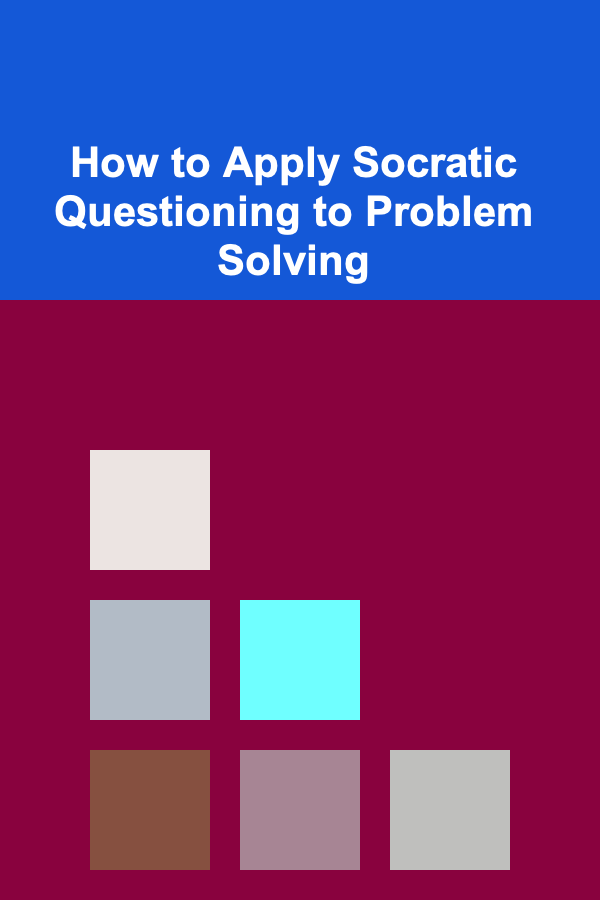
How to Apply Socratic Questioning to Problem Solving
ebook include PDF & Audio bundle (Micro Guide)
$12.99$6.99
Limited Time Offer! Order within the next:

Socratic questioning, named after the ancient Greek philosopher Socrates, is a method of asking and answering questions to stimulate critical thinking and to draw out ideas and underlying assumptions. This method has been a cornerstone of philosophical discourse and can be applied to problem solving in a variety of contexts, whether personal, professional, or academic. By employing Socratic questioning, individuals can approach problems with greater clarity, creativity, and logical rigor, fostering deeper understanding and more effective solutions.
In this article, we will explore how Socratic questioning can be applied to problem solving, breaking down its fundamental components, its benefits, and the practical steps to implement this technique in real-life scenarios.
Understanding Socratic Questioning
Before diving into its application, it's crucial to understand what Socratic questioning is. The core of this method involves the art of asking probing questions that encourage individuals to examine their thoughts, beliefs, and reasoning. Unlike regular questioning that may seek answers or confirm facts, Socratic questioning is designed to encourage exploration and reflection, often leading to new insights or revelations.
Socrates, the man behind this method, used it as a tool to challenge assumptions, clarify concepts, and scrutinize ideas for consistency and validity. His approach was not to give answers, but to lead others toward self-discovery through a series of carefully crafted questions.
The key elements of Socratic questioning include:
- Clarification: Asking for clarification helps individuals to define terms and understand concepts more deeply.
- Probing Assumptions: This step challenges the assumptions that underlie a person's argument or perspective, prompting a closer examination of these foundational beliefs.
- Probing Rationale, Reasons, and Evidence: Here, the goal is to explore the reasoning behind a claim, asking questions like "What is your reasoning?" or "What evidence supports this?"
- Exploring Perspectives: This component encourages individuals to consider different viewpoints and alternative explanations.
- Analyzing Implications and Consequences: Probing the implications of an idea or argument helps individuals to consider the broader impact of their thoughts.
- Questioning the Question: Finally, reflecting on the nature and purpose of the question itself can sometimes provide the most profound insights.
Now that we have a grasp of the basics, let's explore how Socratic questioning can be applied to problem solving.
The Role of Socratic Questioning in Problem Solving
Problem solving is an inherently complex process that requires clear thinking, creative solutions, and a structured approach to finding answers. The traditional problem-solving process often involves identifying the problem, generating potential solutions, evaluating those solutions, and choosing the best one. However, the effectiveness of this process can be hindered by biases, assumptions, or limited perspectives.
Socratic questioning is a powerful tool in the problem-solving process because it forces individuals to slow down and reflect deeply at every step. By applying Socratic principles, you can break down the problem-solving process into more manageable and thoughtful stages.
Step 1: Identifying the Problem
The first and most crucial step in problem solving is clearly identifying the problem. Often, people rush into solutions without truly understanding the issue at hand, which can lead to suboptimal outcomes.
Socratic questioning helps to clarify the problem by asking questions such as:
- What exactly is the problem we are trying to solve?
- What do we know about the problem so far?
- What are the underlying issues or assumptions about this problem?
- Are there any contradictions in how we are perceiving the problem?
By asking these types of questions, individuals can better define the problem and avoid jumping to conclusions too quickly.
Step 2: Exploring Assumptions
In many cases, people approach problems with preconceived assumptions that limit their thinking. These assumptions can create blind spots, which hinder the search for innovative solutions.
Through Socratic questioning, you can probe these assumptions by asking:
- What assumptions are we making about this situation?
- Are these assumptions based on evidence or belief?
- What happens if we challenge these assumptions?
- Can we think of an example where these assumptions do not hold true?
By critically evaluating assumptions, you open the door to new perspectives and prevent the problem-solving process from being constrained by narrow thinking.
Step 3: Generating Alternatives
Once the problem and assumptions are understood, the next step is to generate possible solutions. This is where Socratic questioning plays a crucial role in expanding the range of potential alternatives.
Rather than just focusing on one solution, ask questions like:
- What other solutions could work in this scenario?
- How else might we approach this problem?
- What are the benefits and drawbacks of each solution?
- How would we approach this problem if we had unlimited resources or no constraints?
By questioning the status quo and considering multiple alternatives, you create room for creative and innovative thinking, which can lead to better solutions.
Step 4: Evaluating the Alternatives
Evaluating potential solutions requires critical analysis. Socratic questioning can guide you through this evaluation by encouraging deep thought about the evidence, consequences, and feasibility of each solution.
Here are some Socratic questions to help evaluate alternatives:
- What is the evidence for each solution?
- What are the potential risks and benefits?
- What are the long-term consequences of each solution?
- How feasible is each solution given our resources and constraints?
By asking these questions, you can gain a more nuanced understanding of each option and make an informed decision.
Step 5: Making a Decision
After evaluating the alternatives, the next step is to make a decision. While Socratic questioning has led you to a more thorough exploration of the problem, you must now choose the solution that best fits the situation.
Before finalizing your decision, ask:
- What makes this solution the best choice?
- What are we leaving out by choosing this solution?
- What could go wrong with this solution, and how can we prepare for it?
These reflective questions ensure that your decision is not made hastily and that all aspects of the situation have been considered.
Step 6: Reviewing and Reflecting
After implementing a solution, it is essential to review and reflect on the outcome. Socratic questioning doesn't stop once a decision is made; it should continue throughout the problem-solving process.
Ask:
- What went well with this solution?
- What did we learn from this process?
- What could we have done differently?
- How can we apply what we've learned to future problems?
This reflective process allows you to continually improve your problem-solving skills and learn from each experience.
Practical Examples of Applying Socratic Questioning
Example 1: Problem Solving in Business
Imagine you are a business leader trying to address a drop in sales for your company. Applying Socratic questioning to this problem might involve the following steps:
- Identifying the problem: "What exactly is causing the sales drop? Is it a short-term trend or a longer-term issue?"
- Exploring assumptions: "Are we assuming the market is the problem, or could it be an issue with our product or marketing strategies?"
- Generating alternatives: "What changes can we make to our marketing approach? Can we improve our product or its positioning?"
- Evaluating alternatives: "What would the impact of a price reduction be? How would increasing our advertising affect sales?"
- Making a decision: "Which strategy aligns best with our company's resources and long-term goals?"
- Reviewing and reflecting: "What worked in addressing the sales drop? What could we improve in future decision-making?"
By applying Socratic questioning, you can dissect the problem thoroughly, explore new solutions, and choose the most effective course of action.
Example 2: Personal Problem Solving
Let's say you're struggling with time management and feel overwhelmed with your daily tasks. Using Socratic questioning, you might ask yourself:
- Identifying the problem: "Why do I feel overwhelmed? Is it because I have too much on my plate, or am I not managing my time effectively?"
- Exploring assumptions: "Am I assuming that I can do everything on my own? Is it possible I'm overcommitting myself?"
- Generating alternatives: "What tasks can I delegate? Can I use technology or tools to help me manage my time?"
- Evaluating alternatives: "What impact would delegating tasks have on my stress level? How much time can I save by using a calendar or time management app?"
- Making a decision: "What are the most urgent tasks I need to prioritize? How can I incorporate time-saving tools into my routine?"
- Reviewing and reflecting: "How effective was my time management strategy? What can I do to improve it going forward?"
By systematically applying Socratic questioning, you can gain insights into the root causes of your stress and create more effective time management strategies.
Benefits of Socratic Questioning in Problem Solving
Socratic questioning offers several key benefits for problem solving:
- Enhanced Critical Thinking: By constantly probing assumptions and reasoning, Socratic questioning helps you think critically about every aspect of a problem.
- Greater Clarity: Asking focused questions forces you to define problems more clearly and identify root causes.
- Broader Perspectives: By exploring different viewpoints and challenging your assumptions, you are more likely to consider creative and diverse solutions.
- Improved Decision Making: Socratic questioning leads to more thorough evaluations of options, helping you make better-informed decisions.
- Increased Self-Awareness: The process of questioning encourages self-reflection and helps you become more aware of your biases, limitations, and thinking patterns.
Conclusion
Socratic questioning is an incredibly powerful tool for problem solving. By applying this method, individuals can break down complex problems, challenge their assumptions, generate creative alternatives, and make more thoughtful decisions. Whether in business, personal development, or academic pursuits, the use of Socratic questioning can lead to deeper insights, more effective solutions, and a greater understanding of the issues at hand. Through continuous reflection and inquiry, Socratic questioning fosters a mindset that values curiosity, clarity, and critical thinking---skills that are invaluable in solving problems and navigating the complexities of life.
Reading More From Our Other Websites
- [Home Space Saving 101] How to Keep Your Bathroom Clutter-Free with Small Storage Solutions
- [Organization Tip 101] How to Organize Your Online Learning Materials
- [Stamp Making Tip 101] DIY Storytelling: Crafting Narrative Stamps That Bring Your Personal Tales to Life
- [Home Party Planning 101] How to Plan a Kids' Craft Party: Fun and Creative Ideas for Little Ones
- [Personal Investment 101] How to Leverage Technology in Property Management
- [Home Soundproofing 101] How to Calculate the True Cost of Home Soundproofing and Get the Best Value
- [Home Family Activity 101] How to Have a Successful Family Karaoke Night at Home
- [Organization Tip 101] What Are the Best Ideas for Organizing Your Home Gym?
- [Home Space Saving 101] How to Incorporate Built-In Storage Solutions in Your Home
- [Home Soundproofing 101] How to Soundproof a Tiny Home or Mobile Home

How to Analyze Marketing Campaign Performance for Better Market Insights
Read More
How to Conduct Engaging Remote Meetings
Read More
How to Manage Your Pet's Bathing Routine at Home
Read More
How to Set Up a Pet Activity Zone for Fun and Exercise
Read More
How to Learn Command Line Basics for Developers
Read More
10 Tips for Overcoming Procrastination with a Writing To-Do List
Read MoreOther Products

How to Analyze Marketing Campaign Performance for Better Market Insights
Read More
How to Conduct Engaging Remote Meetings
Read More
How to Manage Your Pet's Bathing Routine at Home
Read More
How to Set Up a Pet Activity Zone for Fun and Exercise
Read More
How to Learn Command Line Basics for Developers
Read More